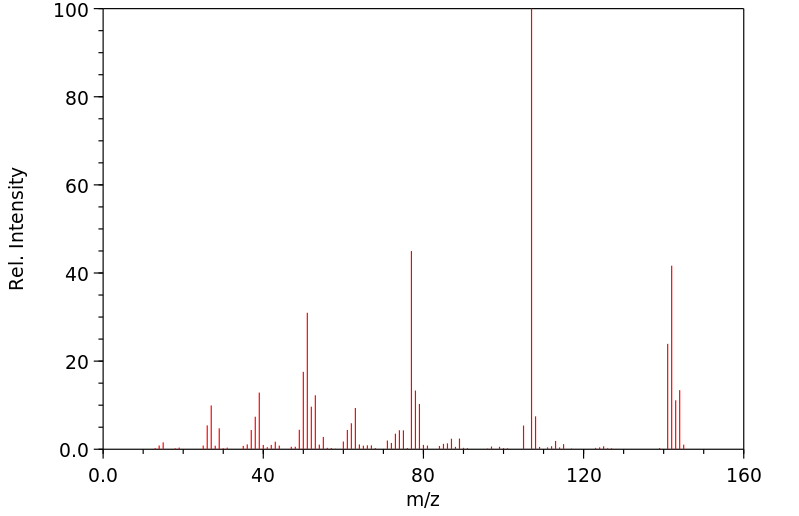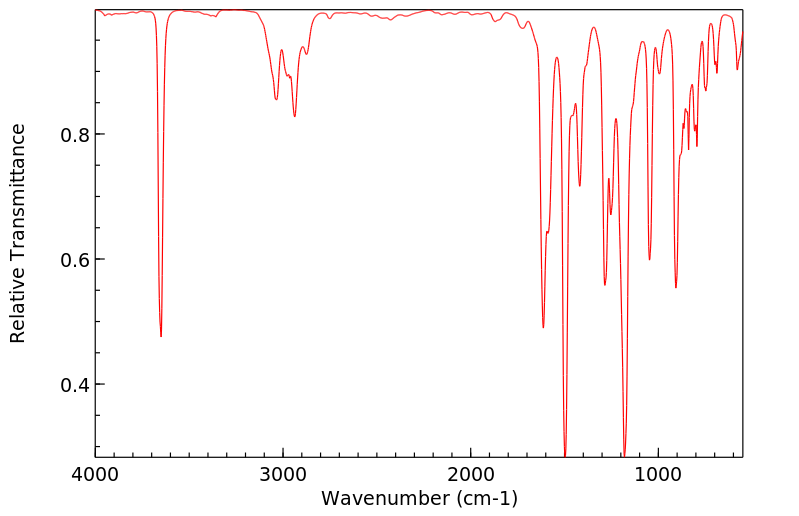3-氯-4-甲基苯酚 | 615-62-3
物质功能分类
中文名称
3-氯-4-甲基苯酚
中文别名
3-氯-4-甲基苯酚,97;3-氯-4-甲基苯酚,97%
英文名称
3-chloro-4-methylphenol
英文别名
3-Chlor-4-methyl-phenol
CAS
615-62-3
化学式
C7H7ClO
mdl
——
分子量
142.585
InChiKey
VQZRLBWPEHFGCD-UHFFFAOYSA-N
BEILSTEIN
——
EINECS
——
-
物化性质
-
计算性质
-
ADMET
-
安全信息
-
SDS
-
制备方法与用途
-
上下游信息
-
文献信息
-
表征谱图
-
同类化合物
-
相关功能分类
-
相关结构分类
物化性质
-
熔点:48-53 °C
-
沸点:228 °C
-
密度:0,963g/cm
-
闪点:228°C
-
溶解度:溶于甲醇
-
最大波长(λmax):283nm(H2O)(lit.)
-
稳定性/保质期:
性质与稳定性:在常温常压下,该物质不会分解。
计算性质
-
辛醇/水分配系数(LogP):3.3
-
重原子数:9
-
可旋转键数:0
-
环数:1.0
-
sp3杂化的碳原子比例:0.14
-
拓扑面积:20.2
-
氢给体数:1
-
氢受体数:1
安全信息
-
TSCA:Yes
-
危险等级:6.1
-
危险品标志:Xi,Xn,T,C
-
危险类别码:R20/21/22
-
危险品运输编号:3437
-
海关编码:2908199090
-
包装等级:II
-
危险类别:6.1
-
安全说明:S23,S36/37/39
-
WGK Germany:3
-
危险性防范说明:P261,P280,P305+P351+P338
-
危险性描述:H302+H312+H332,H315,H319,H335
-
储存条件:贮存: 将密器密封,并储存在密封的主藏器中。应将其放置在阴凉、干燥的位置。
SDS
Section 1. IDENTIFICATION OF THE SUBSTANCE/MIXTURE
Product name : 3-Chloro-4-methylphenol
Section 2. HAZARDS IDENTIFICATION
Classification of the substance or mixture
According to Regulation (EC) No1272/2008
Acute toxicity, Inhalation (Category 4)
Acute toxicity, Dermal (Category 4)
Acute toxicity, Oral (Category 4)
Skin irritation (Category 2)
Serious eye damage (Category 1)
Specific target organ toxicity - single exposure (Category 3)
According to European Directive 67/548/EEC as amended.
Harmful by inhalation, in contact with skin and if swallowed. Irritating to respiratory system and skin. Risk of
serious damage to eyes.
Label elements
Pictogram
Signal word Danger
Hazard statement(s)
H302 Harmful if swallowed.
H312 Harmful in contact with skin.
H315 Causes skin irritation.
H318 Causes serious eye damage.
H332 Harmful if inhaled.
H335 May cause respiratory irritation.
Precautionary statement(s)
P261 Avoid breathing dust/ fume/ gas/ mist/ vapours/ spray.
P280 Wear protective gloves/ eye protection/ face protection.
P305 + P351 + P338 IF IN EYES: Rinse cautiously with water for several minutes. Remove
contact lenses, if present and easy to do. Continue rinsing.
Hazard symbol(s)
Xn Harmful
R-phrase(s)
R20/21/22 Harmful by inhalation, in contact with skin and if swallowed.
R37/38 Irritating to respiratory system and skin.
R41 Risk of serious damage to eyes.
S-phrase(s)
S26 In case of contact with eyes, rinse immediately with plenty of water and
seek medical advice.
S39 Wear eye/face protection.
Other hazards - none
Section 3. COMPOSITION/INFORMATION ON INGREDIENTS
Formula : C7H7ClO
Molecular Weight : 142,58 g/mol
CAS-No. EC-No. Index-No. Classification Concentration
3-Chloro-p-cresol
615-62-3 210-439-1 - Acute Tox. 4; Skin Irrit. 2; Eye -
Dam. 1; STOT SE 3; H302,
H312, H315, H318, H332,
H335
Xn, R20/21/22 - R37/38 - R41
For the full text of the H-Statements mentioned in this Section, see Section 16.
Section 4. FIRST AID MEASURES
General advice
Consult a physician. Show this safety data sheet to the doctor in attendance.
If inhaled
If breathed in, move person into fresh air. If not breathing, give artificial respiration. Consult a physician.
In case of skin contact
Wash off with soap and plenty of water. Consult a physician.
In case of eye contact
Rinse thoroughly with plenty of water for at least 15 minutes and consult a physician.
If swallowed
Never give anything by mouth to an unconscious person. Rinse mouth with water. Consult a physician.
Section 5. FIRE-FIGHTING MEASURES
Suitable extinguishing media
Use water spray, alcohol-resistant foam, dry chemical or carbon dioxide.
Special protective equipment for fire-fighters
Wear self contained breathing apparatus for fire fighting if necessary.
Section 6. ACCIDENTAL RELEASE MEASURES
Personal precautions
Use personal protective equipment. Avoid dust formation. Avoid breathing vapors, mist or gas. Ensure
adequate ventilation. Evacuate personnel to safe areas. Avoid breathing dust.
Environmental precautions
Do not let product enter drains.
Methods and materials for containment and cleaning up
Pick up and arrange disposal without creating dust. Sweep up and shovel. Keep in suitable, closed
containers for disposal.
Section 7. HANDLING AND STORAGE
Precautions for safe handling
Avoid contact with skin and eyes. Avoid formation of dust and aerosols.
Provide appropriate exhaust ventilation at places where dust is formed. Normal measures for preventive fire
protection.
Conditions for safe storage
Keep container tightly closed in a dry and well-ventilated place. Store in cool place.
Section 8. EXPOSURE CONTROLS/PERSONAL PROTECTION
Personal protective equipment
Respiratory protection
Where risk assessment shows air-purifying respirators are appropriate use a full-face particle respirator
type N100 (US) or type P3 (EN 143) respirator cartridges as a backup to engineering controls. If the
respirator is the sole means of protection, use a full-face supplied air respirator. Use respirators and
components tested and approved under appropriate government standards such as NIOSH (US) or CEN
(EU).
Hand protection
Handle with gloves. Gloves must be inspected prior to use. Use proper glove removal technique (without
touching glove's outer surface) to avoid skin contact with this product. Dispose of contaminated gloves
after use in accordance with applicable laws and good laboratory practices. Wash and dry hands.
The selected protective gloves have to satisfy the specifications of EU Directive 89/686/EEC and the
standard EN 374 derived from it.
Eye protection
Face shield and safety glasses Use equipment for eye protection tested and approved under appropriate
government standards such as NIOSH (US) or EN 166(EU).
Skin and body protection
Complete suit protecting against chemicals, The type of protective equipment must be selected according
to the concentration and amount of the dangerous substance at the specific workplace.
Hygiene measures
Handle in accordance with good industrial hygiene and safety practice. Wash hands before breaks and at
the end of workday.
Section 9. PHYSICAL AND CHEMICAL PROPERTIES
Appearance
Form solid
Safety data
pH no data available
Melting point 48 - 53 °C
Boiling point 228 °C at 1.013 hPa
Flash point no data available
Ignition temperature no data available
Lower explosion limit no data available
Upper explosion limit no data available
Water solubility no data available
Partition coefficient: log Pow: 2,778
n-octanol/water
Section 10. STABILITY AND REACTIVITY
Chemical stability
Stable under recommended storage conditions.
Conditions to avoid
no data available
Materials to avoid
Oxidizing agents
Hazardous decomposition products
Hazardous decomposition products formed under fire conditions. - Carbon oxides, Hydrogen chloride gas
Section 11. TOXICOLOGICAL INFORMATION
Acute toxicity
no data available
Skin corrosion/irritation
no data available
Serious eye damage/eye irritation
no data available
Respiratory or skin sensitization
no data available
Germ cell mutagenicity
no data available
Carcinogenicity
IARC: No component of this product present at levels greater than or equal to 0.1% is identified as
probable, possible or confirmed human carcinogen by IARC.
Reproductive toxicity
no data available
Specific target organ toxicity - single exposure
Inhalation - May cause respiratory irritation.
Specific target organ toxicity - repeated exposure
no data available
Aspiration hazard
no data available
Potential health effects
Inhalation Harmful if inhaled. Causes respiratory tract irritation.
Ingestion Harmful if swallowed.
Skin Harmful if absorbed through skin. Causes skin irritation.
Eyes
Causes eye burns.
Signs and Symptoms of Exposure
To the best of our knowledge, the chemical, physical, and toxicological properties have not been thoroughly
investigated.
Additional Information
RTECS: Not available
Section 12. ECOLOGICAL INFORMATION
Toxicity
no data available
Persistence and degradability
no data available
Bioaccumulative potential
no data available
Mobility in soil
no data available
PBT and vPvB assessment
no data available
Other adverse effects
no data available
Section 13. DISPOSAL CONSIDERATIONS
Product
Offer surplus and non-recyclable solutions to a licensed disposal company. Contact a licensed professional
waste disposal service to dispose of this material. Dissolve or mix the material with a combustible solvent
and burn in a chemical incinerator equipped with an afterburner and scrubber.
Contaminated packaging
Dispose of as unused product.
Section 14. TRANSPORT INFORMATION
ADR/RID
Not dangerous goods
IMDG
Not dangerous goods
IATA
Not dangerous goods
Section 15. REGULATORY INFORMATION
This safety datasheet complies with the requirements of Regulation (EC) No. 1907/2006.
Section 16. OTHER INFORMATION
Text of H-code(s) and R-phrase(s) mentioned in Section 3
Acute Tox. Acute toxicity
Eye Dam. Serious eye damage
H302 Harmful if swallowed.
H312 Harmful in contact with skin.
H315 Causes skin irritation.
H318 Causes serious eye damage.
H332 Harmful if inhaled.
H335 May cause respiratory irritation.
Skin Irrit. Skin irritation
STOT SE Specific target organ toxicity - single exposure
Xn Harmful
R20/21/22 Harmful by inhalation, in contact with skin and if swallowed.
R37/38 Irritating to respiratory system and skin.
R41 Risk of serious damage to eyes.
Further information
Copyright 2010 Co. License granted to make unlimited paper copies for internal use only.
The above information is believed to be correct but does not purport to be all inclusive and shall be used
only as a guide. The information in this document is based on the present state of our knowledge and is
applicable to the product with regard to appropriate safety precautions. It does not represent any guarantee
of the properties of the product. Co., shall not be held liable for any damage resulting from
handling or from contact with the above product. See reverse side of invoice or packing slip for additional
terms and conditions of sale.
上下游信息
-
上游原料
中文名称 英文名称 CAS号 化学式 分子量 2-氯甲苯 2-Chlorotoluene 95-49-8 C7H7Cl 126.586 -
下游产品
中文名称 英文名称 CAS号 化学式 分子量 3-氯-4-甲基苯甲醚 2-chloro-4-methoxy-1-methylbenzene 54788-38-4 C8H9ClO 156.612 2,5-二氯-4-甲基-苯酚 2,5-dichloro-4-methyl-phenol 38946-60-0 C7H6Cl2O 177.03 —— 2-methyl-5-ethoxychlorobenzene 219768-05-5 C9H11ClO 170.639 —— 2-chloro-4-methoxymethoxytoluene 911718-06-4 C9H11ClO2 186.638 —— 2-(3-Chloro-4-methylphenoxy)acetonitrile —— C9H8ClNO 181.622 —— 2-chloro-4-isopropoxy-1-methylbenzene 1254062-70-8 C10H13ClO 184.666 2-氯-4-甲氧基溴苄 2-chloro-4-methoxybenzyl bromide 54788-17-9 C8H8BrClO 235.508 —— 2-bromo-5-chloro-4-methylphenol 1175754-49-0 C7H6BrClO 221.481 —— 2-chloro-1-methyl-4-(2,2,2-trifluoroethoxy)benzene 1254062-72-0 C9H8ClF3O 224.61 —— 3-Chloro-4-methylphenyl acetate 129930-85-4 C9H9ClO2 184.622 —— 2-chloro-4-(3-chloro-4-methyl-phenoxy)-benzonitrile 1246685-62-0 C14H9Cl2NO 278.138 —— 2-Bromomethyl-5-ethoxychlorobenzene 219768-06-6 C9H10BrClO 249.535 - 1
- 2
反应信息
-
作为反应物:描述:3-氯-4-甲基苯酚 在 sodium hydroxide 、 potassium permanganate 、 戊醇 、 水 、 铜 、 potassium carbonate 作用下, 生成 4-甲氧基-2-(苯基氨基)苯甲酸参考文献:名称:Ullmann; Wagner, Justus Liebigs Annalen der Chemie, 1907, vol. 355, p. 366摘要:DOI:
-
作为产物:描述:参考文献:名称:Fischer, Alfred; Henderson, George N.; RayMahasay, Sumit, Canadian Journal of Chemistry, 1987, vol. 65, p. 1233 - 1240摘要:DOI:
文献信息
-
[EN] CHROMAN-4-ONE DERIVATIVES FOR THE TREATMENT AND PROPHYLAXIS OF HEPATITIS B VIRUS INFECTION<br/>[FR] DÉRIVÉS DE CHROMAN-4-ONE POUR LE TRAITEMENT ET LA PROPHYLAXIE D'UNE INFECTION PAR LE VIRUS DE L'HÉPATITE B申请人:HOFFMANN LA ROCHE公开号:WO2020120642A1公开(公告)日:2020-06-18The present invention provides compounds having the general formula (I) wherein R1 to R10, Gi, G2, X and m are as described herein, compositions including the compounds and methods of using the compounds for treating hepatitis B.本发明提供具有一般式(I)的化合物,其中R1至R10、Gi、G2、X和m如本文所述,包括这些化合物的组合物以及使用这些化合物治疗乙型肝炎的方法。
-
The reactions of unactivated aryl halides with sodium methoxide in HMPA作者:L. Testaferri、M. Tiecco、M. Tingoli、D. Chianelli、M. MontanucciDOI:10.1016/s0040-4020(01)97647-1日期:——Sodium methoxide reacts with dichlorobenzenes in HMPA to give the chloroanisoles as a result of a SNAr process. Excess MeONa then effects the demethylation of the ethers to give the chlorophenols via an SN2 reaction. With tri- and tetrachlorobenzenes the initially formed chloroanisoles can be dealkylated to chlorophenols or can suffer further substitution to give the chlorodimethoxybenzenes; these
-
Substituted N, N-disubstituted diamino compounds useful for inhibiting cholesteryl ester transfer protein activity申请人:——公开号:US20020120011A1公开(公告)日:2002-08-29The invention relates to substituted polycyclic aryl and heteroaryl tertiary-heteroalkylamine compounds useful as inhibitors of cholesteryl ester transfer protein (CETP; plasma lipid transfer protein-I) and compounds, compositions and methods for treating atherosclerosis and other coronary artery diseases. Preferred tertiary-heteroalkylamine compounds are substituted N,N-disubstituted diamines. A preferred specific N,N-disubstituted diamine is the compound: 1
-
[EN] ARYLMETHYLENE HETEROCYCLIC COMPOUNDS AS KV1.3 POTASSIUM SHAKER CHANNEL BLOCKERS<br/>[FR] COMPOSÉS HÉTÉROCYCLIQUES D'ARYLMÉTHYLÈNE UTILISÉS EN TANT QUE BLOQUEURS DES CANAUX POTASSIQUES KV1.3 DE TYPE SHAKER申请人:DE SHAW RES LLC公开号:WO2021071806A1公开(公告)日:2021-04-15A compound of Formula (I) or a pharmaceutically acceptable salt thereof is described, wherein the substituents are as defined herein. Pharmaceutical compositions comprising the same and method of using the same are also described.描述了化合物的公式(I)或其药学上可接受的盐,其中取代基如本文所定义。还描述了包含相同化合物的药物组合物以及使用该药物的方法。
-
5,6-BISARYL-2-PYRIDINE-CARBOXAMIDE DERIVATIVES, PREPARATION AND APPLICATION THEREOF IN THERAPEUTICS AS UROTENSIN II RECEPTOR ANTAGONISTS
表征谱图
-
氢谱1HNMR
-
质谱MS
-
碳谱13CNMR
-
红外IR
-
拉曼Raman
-
峰位数据
-
峰位匹配
-
表征信息
同类化合物
(2-氯-6-羟基苯基)硼酸
黄柄曲菌素
高香草酸-d3
高香草酸-13C6
高香草酸
高香兰酸乙酯
高辣椒素II
高二氢辣椒素I
香草醛醛肟
香草醛苯腙
香草醛-甲氧基-13C
香草醛-(N-对甲苯基肟)
香草醛
香草酸肼
香草壬酰胺
香草基扁桃酸乙酯
香草吗啉
香草二乙胺
香兰素胺硬脂酸盐
香兰素胺硬脂酸盐
香兰素胺盐酸盐
香兰素丙二醇缩醛
香兰素13C6
香兰素-D3
香兰基乙基醚
香兰基丁醚
顺式-5-正十五碳-8'-烯基间苯二酚
顺式-1-(2-羟基-5-甲基苯基)-2-丁烯-1-酮
顺式-1-(2-羟基-4-甲氧基苯基)-2-丁烯-1-酮
顺-3-氯二氢-5-苯基呋喃-2(3H)-酮
雌二醇杂质1
降二氢辣椒碱
阿诺洛尔
阿瓦醇
阿普斯特杂质
间苯二酚双(二苯基磷酸酯)
间苯二酚-烯丙醇聚合物
间苯二酚-D6
间苯二酚
间苯三酚甲醛
间苯三酚二水合物
间苯三酚
间羟基苯乙基溴
间硝基苯酚
间甲酚紫钠盐
间甲酚与对甲酚和苯酚甲醛树脂的聚合物
间甲酚-D7
间甲酚-D3
间甲酚
间溴苯酚








